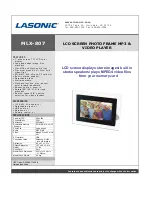
OPERATING AND USER MANUAL QUARTZ series CXP
41
Performing Flat Field set Calibrations
6.11.3.
The procedure of performing a calibration is shown in the flow chart in figure 6.6. It is adviced to follow
the steps carefully. Some of the blocks require more explanation, which is given below.
CalibrationTypeSelector
Four calibration types are possible:
AverageBlackLevelCalibration
•
Only the average black level is calibrated to the BlackLevelRaw value (see section 6.6).
FullDarkFieldCalibration
•
The complete dark field is calibrated on a per pixel basis.
IncrementalDarkFieldCalibration
•
A single additional dark frame is captured and used to update the dark field map, on a per pixel
basis.
GainCalibration
•
The camera gain map is calibrated on a per pixel basis.
NOTE: if the camera is one of the control modes, this requires sending 64 triggers to the camera
during the actural calibration.
CalibrationFlatFieldSetSelector
This determines the gain set that is calibrated, ranging from 1 to 4.
CalibrationFlatFieldMode
When set to LocalGainCorrection only pixel to pixel variation is corrected for.
When set to GlobalGainCorrection the complete image is flat-fielded including both local pixel to pixel
variations and global shading originating from optics and illumination.
CalibrationFlatFieldExposureMode
When set to AutoLevelAdjust, during gain calibration an auto exposure control loop in the camera will
set the integration time to meet an average level set by CalibrationFlatFieldExposureSetPoint.
This only works when the camera runs in Timed mode.
When set to NoAdjust, the gain calibration will be done directly brought to the camera by illumination
and integration time.
CalibrationFlatFieldExecute
After this command, the camera executes the calibrations autonomously except in the case of gain
calibration in either control mode. In that case, the camera needs to be triggered 64x at a rate of <130
fps. Note that during the calibration no images are output.
The calibration may take a couple of seconds.
CalibrationFlatFieldLoadSaveSetSelector
After any calibration is performed, the correction map is only in volatile memory (RAM). It needs to be
saved in non-volatile memory by entering a sequence of commands (last 3 blocks in flow chart figure
6.6).
CalibrationFlatFieldLoadSaveSetSelector determines which set to save.
If one just performed any dark field calibration, this should be set to OffsetReferenceImage.





































